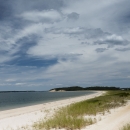Facility
Location
Sag Harbor, NY 11963
United States
Volunteer Position Overview
About This Position
Unfortunately, due to the public-facing nature of our RV program, we cannot host a RV volunteer with a dog. If you like interacting with people, both young and old, this is the volunteer position for you!! This volunteer position interacts closely with Long Island Refuge Complex’s Visitor Services team. Stationed at Elizabeth A. Morton National Wildlife Refuge, volunteers will focus their energies: Staffing the Complex’s visitor contact station (Meet and cheerfully greet visitors, provide area and refuge recreation opportunity information, give orientations to the work of the U.S. Fish and Wildlife Service and the National Wildlife Refuge System; assist visitors with refuge rules and regulations; concisely explain the refuge entrance fee options; answer telephones, answer visitor questions, respond to visitor correspondences, distribute brochures and restock brochures.); Roving refuge trails to educate refuge visitors (Engage refuge visitors as they walk trails and look for wildlife, show wildlife related props and photos.); Doing clerical activities (Filing, answering the phone at the front desk, researching refuge history at local libraries and organizing Complex’s image library.); Photographing a variety of natural resources; and performing basic maintenance duties (Maintain cleanliness of public restrooms; pick up and dispose of litter found along roadways, trails and visitor areas).
One RV pad is located at this national wildlife refuge. The pad is crushed gravel and has full hook ups (water, electric and sewer). Amenities for RV volunteers include a picnic table and access to a washer/dryer in the headquarters or intern building. On the job training will be provided.
To apply: Applications will be accepted on a rolling basis, with selections made in mid-February. Contact Ann Marie Chapman at (631) 286-0485 ext. 2131 or AnnMarie_Chapman@fws.gov (If emailing, in the subject line, type in your name followed by the position you are applying for. Example: Ann Marie Chapman: Morton Refuge RV Volunteer). You will be sent an application and requested to send a photo of you and your RV.
Duties/Activities
Stories About Volunteering
Other Ways to Work with Us
Are you looking for something different than a volunteer opportunity? The Fish and Wildlife Service employs around 9,000 people nationwide and offers great internship opportunities every year.






